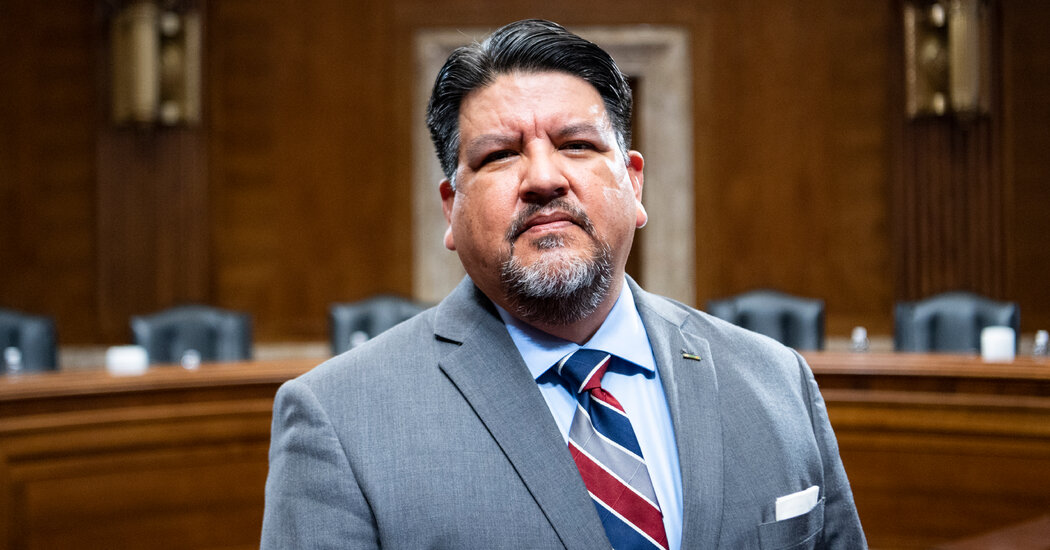
Last December, Charles F. Sams III made history when he became the first Native American to be appointed director of the National Park Service. He had his work cut out for him.
The number of visitors to the biggest parks in the United States is at an all-time high, road repairs and other infrastructure upgrades are badly needed and climate change poses an increasing threat through coastal erosion, landslides, floods and other effects. To address these issues, Congress in 2020 passed a $9.5 billion package known as the Great American Outdoors Act, which Mr. Sams will help implement.
It’s a big job, yet Mr. Sams has spent a career navigating the complexities of tribal land management. Most recently, he served as the executive director of the Confederated Tribes of Umatilla Indian Reservation in northeast Oregon, where he now lives. Mr. Sams, who is Cayuse and Walla Walla, credited his grandfather with instilling in him a responsibility to native plants and wildlife.
“He would ask me questions from time to time, to paint a picture of our relationship, as humans, with the flora and fauna,” he said. “That was an important part of my education growing up.”
This conversation has been edited for clarity and length.
What was it like to be sworn in on the steps of the Lincoln Memorial?
Interior Secretary Deb Haaland and I went to the second landing of the marble steps, and she had me look down at my feet, so I could recognize that I was standing where Dr. King gave his “I Have a Dream” speech. Ms. Haaland, who is Native American, said, “we are embodying Dr. King’s dream.” I was greatly honored.
Secretary Haaland has spoken about the importance of accessibility. What have been the challenges to making our parks accessible to all Americans?
One issue stems from affordability. In Florida, we’ve partnered with the cities of Homestead and Miami and are running buses out to Biscayne and Everglades in order for low-income families to get out into the parks system.
Many parks were built in the 1920s, 30s and 40s, and didn’t have A.D.A. accessibility. We’re very pleased to use a portion of the Great American Outdoors Act money to offer upgrades so folks who may have disabilities can experience the parks in a different way. For example, in Washington, there are now smaller versions of statues at the Franklin Delano Roosevelt Memorial visitors center, so folks who have sight issues can have that tactile experience.
You previously served as executive director of the Confederated Tribes of the Umatilla Indian Reservation. How did that experience prepare you for this role?
The reservation was established by a treaty in 1855, and my great-great-great grandfather Peo Peo Mox Mox, the head man of the Walla Walla people, was a signer of that treaty. He and my ancestors originally thought they had reserved 500,000 acres, but it ended up being 250,000 acres. Due to the Allotment Act in 1887, it became a ‘checkerboard reservation,’ so we have a mixture of Indian and non-Indian residents in an area in which our tribe has legal jurisdiction.
Leading a tribe, and being able to work with both tribal members and nontribal members, along with the infrastructure and economic development on a reservation, gave me a pretty good grounding on how to manage budgets and resources.
Some parks, like Arches, Rocky Mountain and Yosemite, have recently introduced timed-entry systems to manage with overcrowding. How do you ensure the protection of these fragile landscapes while keeping them open to the public?
As more Americans are getting outdoors and recreating, we want to encourage that. We just need to be better staffed and manage this in the best way possible.
How?
Our staff numbers are down by nearly 15 percent to where we were a decade ago, even though visitation has increased over 20 percent. For fiscal year 2022, Congress has authorized the funding of 1,000 new positions. That will help us have the boots on the ground to manage this very complex issue.
One way to manage the influx of traffic is through technology. We’d love for people to download the NPS app. Our app helps people plan their time in parks, so they can look at the best time of the year, or the best time of the day to get into the park. They can use that info to help them navigate their trip.
Are there parks or regions where you’d like to see more visitation?
While we have some very beautiful large parks — the major 63 parks are magnificent, and I wouldn’t ever say that somebody shouldn’t go see them — I think some folks are missing out on some of the smaller parks.
I recently took my family to Prince William Forest Park, which is an hour outside of Washington, D.C. The O.S.S., which was a precursor to the C.I.A., had used it as a training facility, and they have these little cabins built during World War II. It was also part of George Washington’s march when he was going after the British at Yorktown. I wanted to expose my 8-year-old daughter to that history.
At the Whitman Mission in Washington State, signs were recently updated to reflect a more nuanced version of historical events. Is there a focus now to include more Indigenous history in the parks?
We received very clear direction from President Biden and Secretary Haaland to really lean in and tell America’s untold stories, even those that may be difficult. So yes, we are going out there and working with a host of scholars and community members who know the rich history of their own lands, to help us tell a mosaic of stories.
As more tribal nations are invited to comanage federal land — like in Canyon de Chelly National Monument and Glacier Bay National Park — how will this impact the day-to-day experience for visitors?
In general, it’s not going to affect day-to-day visitors. But as we work closer with tribes, whether through co-stewardship or comanagement, we’re going to see a richer capability of preservation efforts for native species like buffalo and wolves. Native people have lived on this landscape for at least 10,000 years, if not longer. Over the years we’ve ignored those folks who have lived here the longest, who may have the advantage of observational knowledge to help protect these parks that we love so much.




